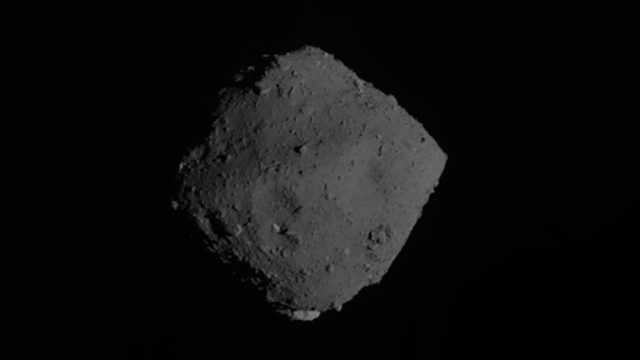
Japanese Asteroid Probe Tests Ion Engine for Journey Home to Earth
Hayabusa2 will fire up its ion engine in earnest on Dec. 3.

A Japanese asteroid probe is getting fired up for its return to Earth.
A recent test of the ion engine that powers Japan's Hayabusa2 spacecraft went well, clearing the hardware for full-on operations soon, mission team members announced late last week.
"This trial run has not had any problems, and the preparations for the ion engine operation during the cruise phase of the return journey are complete," the official Twitter account of the Hayabusa2 mission stated on Nov. 28.
Related: Photos: Japan's Hayabusa2 Asteroid Sample-Return Mission
Ion-engine operation for the return cruise to Earth will start on Tuesday (Dec. 3), a key date for the Hayabusa2 mission.
"We are finally beginning full-scale return operations,” Hayabusa2 team members said in another Nov. 28 tweet. "Incidentally, December 3 is also the 5th anniversary of the launch of Hayabusa2!”
Departure
Hayabusa2 left the near-Earth asteroid Ryugu on Nov. 13, 2019, utilizing chemical propulsion thrusters for the spacecraft’s orbit control.
Get the Space.com Newsletter
Breaking space news, the latest updates on rocket launches, skywatching events and more!
The probe had been studying Ryugu up close since June 2018. During its time at the asteroid, Hayabusa2 dropped several smaller probes onto Ryugu's rubbly surface and collected multiple samples, which will be returned to Earth in December 2020.
The Japan Aerospace Exploration Agency (JAXA) is currently working with the Australian government to support the recovery of the Hayabusa2 reentry capsule in late 2020 at the Woomera Prohibited Area, located in the outback desert of South Australia.
The Hayabusa2 spacecraft itself will cruise past Earth and potentially explore another asteroid target, if JAXA approves an extended mission.
- Watch Japan's Hayabusa2 Grab a Piece of an Asteroid in This Incredible Video!
- Shadow Selfie! Japanese Asteroid Probe Snaps Amazing Post-Landing Pic
- Japan's Hopping Rovers Capture Amazing Views of Asteroid Ryugu (Video)
Leonard David is author of the recently released book, "Moon Rush: The New Space Race" published by National Geographic in May 2019. A longtime writer for Space.com, David has been reporting on the space industry for more than five decades. Follow us on Twitter @Spacedotcom or Facebook.

Join our Space Forums to keep talking space on the latest missions, night sky and more! And if you have a news tip, correction or comment, let us know at: community@space.com.

Leonard David is an award-winning space journalist who has been reporting on space activities for more than 50 years. Currently writing as Space.com's Space Insider Columnist among his other projects, Leonard has authored numerous books on space exploration, Mars missions and more, with his latest being "Moon Rush: The New Space Race" published in 2019 by National Geographic. He also wrote "Mars: Our Future on the Red Planet" released in 2016 by National Geographic. Leonard has served as a correspondent for SpaceNews, Scientific American and Aerospace America for the AIAA. He has received many awards, including the first Ordway Award for Sustained Excellence in Spaceflight History in 2015 at the AAS Wernher von Braun Memorial Symposium. You can find out Leonard's latest project at his website and on Twitter.









